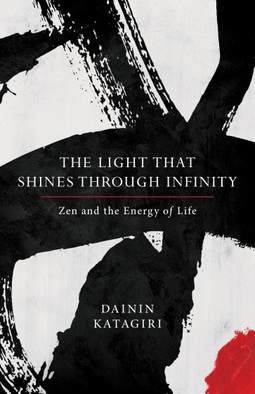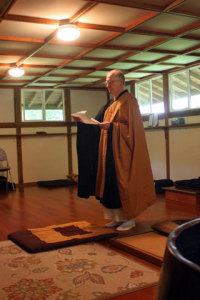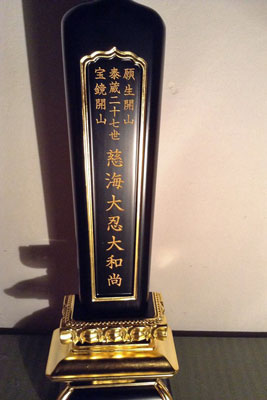|
Today is the anniversary of Katagiri Roshi’s death in 1990. Following Zen tradition, as the end of his life came into view, he composed this bequeathed verse, known as a yuige:
Living in vow, silently sitting Sixty-three years Plum blossoms begin to bloom The jeweled mirror reflects truth as it is Shohaku Okumura Roshi gave an excellent talk on this yuige to the MZMC community last November. He said that while he was long familiar with the poem, recently seeing it written in Japanese had given him new insight into its meaning. This is a wonderful talk to listen to. You can find it at: https://www.youtube.com/watch?v=Xs_sWLkyS5o Peace, Andrea We celebrated Katagiri Roshi’s 96th birthday last week (although it’s been 34 years since we celebrated it with him). In 2024, honoring Soto Zen’s Chinese roots, we also celebrate the Year of the Dragon. Emyo Nakayama, one Katagiri Roshi’s original dharma heirs, recently offered these wonderful words on dragons, and the significance of his birth in a dragon year:
“Katagiri Roshi was born in a dragon year. The dragon is characterized by a lot of energy/power and people born in these years are charismatic, intelligent, confident, and lucky. When I was given something by him - be it instruction or something like a book - he referred to it as "the dew of a dragon". I have never forgotten that and in this new year, I am reminded all the more of his gifts to me. In Chinese Zen Buddhist teaching, the dragon is a symbol of attainment, and many stories talk about something that perseveres and in the blink of an eye becomes a dragon. Katagiri Roshi was, more than anyone I have ever known, a person who persevered. For this reason, I will always think of him together with the image of a dragon.” With appreciation, Andrea Here at the Katagiri Project, we do our best to maintain a chart of Katagiri Roshi’s dharma family. The lineage chart is a family tree of the priests and lay teachers in the Katagiri lineage who have received dharma transmission or are actively engaged in practice that might lead to that. Katagiri Roshi formally entrusted his dharma to twelve priests in 1989. Now his dharma family tree has 122 names in five generations. Folks in the fifth generation can name Katagiri Roshi as their dharma great-great grandfather!
We recently posted an updated version of the lineage chart (www.mnzencenter.org/biography-and-lineage.html). If you know of other people who belong in the chart, or any other updates, please let me know about them via info@mnzencenter.org. Thank you so much! Peace, Andrea The new Katagiri Roshi book, The Light That Shines through Infinity: Zen and the Energy of Life, goes on sale November 28, but you can read a little of it now! On their website, Shambhala Publications has added a Browse Inside feature to the book. It gives you the whole first chapter, along with my editor’s preface.
Hope you enjoy! Peace, Andrea  Wonderful news! Katagiri Roshi’s new book, The Light That Shines through Infinity: Zen and the Energy of Life, will be published by Shambhala on November 28, 2017. Pre-orders can be made now at most booksellers. Here’s the description on the back cover: “The universe is alive with a dynamic energy that creates and sustains our lives. It surrounds us, flows through us, and is available to us in every moment. Spiritual practice, according to Dainin Katagiri Roshi, is about aligning ourselves with this everpresent life force–sometimes referred to as chi, qi, or ki. This collection, edited from his talks, focuses on cosmic energy as it relates to all aspects of Zen practice. With references to classic texts and personal stories that bring the teachings to life, The Light That Shines through Infinity is also a powerful antidote to the notion that practice is in some way about transcending the world around us. It is in fact about nothing other than relating to it compassionately and wholeheartedly.” March 1 is an significant date for me. It is the day in 1980 that I received lay ordination from Katagiri Roshi. It is also the day in 1990 that he died. Today, in memory of Katagiri’s passing, I give you his poem “Peaceful Life.” He wrote this wonderful poem while teaching at Hokyoji in southeast Minnesota, just a few months before cancer forced him to retire.
Recently I was reading Shohaku Okumura’s excellent book “Living by Vow” (Wisdom, 2012) and was happily surprised to find his insightful commentary on “Peaceful Life” as an explanation of the Four Noble Truths. Another significant commentary was made by Zoketsu Norman Fischer, who spoke about the poem and Katagiri in a 2006 dharma talk. You can find that audio file posted here on the website of Norm’s Everyday Zen Foundation. Peace, Andrea Peaceful Life by Dainin Katagiri Being told that it is impossible, One believes, in despair, “Is that so?” Being told that it is possible, One believes, in excitement, “That’s right.” But, whichever is chosen, It does not fit one’s heart neatly. Being asked, “What is unfitting?” I don’t know what it is. But my heart knows somehow. I feel an irresistible desire to know. What a mystery “human” is! As to this mystery: Clarifying, Knowing how to live, Knowing how to walk with people, Demonstrating and teaching, This is the Buddha. From my human eyes, I feel it’s really impossible to become a Buddha. But this “I”, regarding what the Buddha does, Vows to practice, To aspire, To be resolute, And tells myself, “Yes, I will.” Just practice right here now, And achieve continuity, Endlessly, Forever. This is living in vow. Herein is one’s peaceful life found.  Dokai Georgesen, Hokyoji’s head teacher and a dharma heir of Katagiri Roshi, offered these heartfelt dharma words to his teacher during the recent 25-year memorial ceremony: Dear Hojo san, It is clear to me that I do not know who I am, where I am, what I am doing or how I am doing. It is also with astounding clarity that I see this all has something to do with our encounter with each other. For this I will be eternally grateful, as I am every morning when I offer you a little water to drink and a bow. I know you felt the same. It all had to do with some people who you encountered as well who I never met. It is clear that there is transmission between human beings—something is intimately communicated. There is nothing in the entire world with all of our exact science and sophisticated knowledge that is more real than this. What it is, however, defies description—once there are words, generally speaking, confusion arises so easily. Even Gautama was very careful about this. All I can say is it is about you and me and at the same time it is not. The same can be said even about Gautama, himself, and all those before and after him. So I take care of this moment the best that I can—the same as you did—acknowledging that we are not so strong as we would like to be and knowing that at times there is some aimless wandering with disregard for careful attention. We have chosen to live a way in this world in which all we experience is just the continuous suffering of all creatures, large and small, human and non-human. Our hearts are always breaking with desire for it to cease. You were taught and taught to me; do not stay here for long; take a step forward, hold and embrace this breaking with subtle delicacy. Not knowing what to do and just letting the pain in as far as it can go, trust. In some way or another, our hearts mend and open again. Joy and contentment touch us and everything is perfectly fine, just the way it always has been. Dokai Katagiri Roshi passed away 25 years ago on March 1. Today, this inspiring eko was chanted at a special service held at Hokyoji, the rural practice center in rural Eitzen, Minnesota, that he founded:
The body of the pure dharma world Neither appears nor disappears. The strength of the vow of great compassion Manifests in life and death Revering the Buddhas, We aspire to have their illuminating wisdom shine upon us. Prostrating ourselves before the Buddhas, We aspire to have their true compassion embrace us. Today we gather to offer incense, flowers, candlelight, sweet water and tea. We respectfully chant the Song of Jewel Mirror Samadhi and the Dai Hi Shin Darani. The merit of this recitation is dedicated to the great teacher in America and this temple’s founder. Jikai Danin Daiosho. Humbly we offer our deepest graditude. We yearn for the teaching of his dharma. As the sun and moon break the darkness, so the eye of the dharma will illuminate our path. May his magnanimous teaching embrace the earth And continue as a stone of iron. Living in vow he transmitted the ancient way. The path glitters in the moonlight, sometimes it takes lightning and thunder to awaken us. With his whole body he penetrated the ancestors’ marrow, Cultivating the clouds and planting the pines. Thereupon, all creation rejoices and reflects its beauty in this sangha. Luxuriant leaves and blossoms are flourishing in this temple and great trees are attended to and are growing strong. The gates are open inside and out. Respectfully, we offer our true heart. May it limitlessly fill the Tathagata’s bowl. Greetings to everyone who is thinking fondly of our great teacher, and his passing twenty-five years ago today. Our hearts are together.
Jikai Dainin Daiosho, Katagiri Roshi’s dharma name plus honorific title, is the last in the long list of the “Names of Buddhas and Ancestors” that is chanted at Zen centers within his lineage. After reciting those names, we dedicate our effort, saying: We express our heartfelt gratitude And acknowledge our debt To all successive Buddhas and Ancestors who have transmitted the right dharma through India, China, and Japan Teijo Munnich, abbess of Great Tree Zen Temple in Asheville, North Carolina, recently performed a memorial service for Katagiri Roshi and placed an ihai memorial tablet (there’s a photo of it at the end of this post) on the altar at Fudenji in Salsomaggiore, Italy. Right before that, she performed a ceremony to “open the eyes” of the tablet, when it’s customary to speak directly to the item. Here are the moving words that Teijo spoke--
Jikai Dainin Daiosho (Compassionate Ocean, Great Patience, Great Priest) Tomorrow is the 25th anniversary of your passing from the human realm. This ihai is a reminder of your life, of your great patience and steadfast perseverance. We met in California almost 40 years ago; both of us were visitors from Minneapolis. Now I wear your okesa even with its wax stain on the front, I wear your kimono with mold stains which will not come out, and your teachings are still warm in my heart. You shared teachings in Japan and America and inspired many. And Taiten Roshi has shared some of your spirit in Fudenji in Italy, a place where you wanted to visit—but you died too soon. You told us, “Please don’t call me ‘Zen Master.’ No one can master Zen.” And you also said, “Do not make me into a god after I die.” Your humanness was your greatest teaching. Your mistakes were an encouragement to your students. Your continuous effort was your greatest gift. Compassionate Ocean Great Patience, we bow to you in gratitude for your example. And we vow to make our best effort to continue the pure Dharma you embodied. So, how did this come about? In November 1988, Katagiri Roshi was head teacher of the Tokubetsu sesshin, a month-long retreat that brought together Western and Eastern Zen teachers. One of those Westerners was Taiten Guareschi, abbot of Fudenji, who found practicing with Katagiri to be a transformative experience. In remembrance of their connection, he wanted to honor the 25th anniversary of Katagiri’s passing. Yes, in America we honored the 24th anniversary on March 1, but in the Japanese way of counting, the first anniversary of an event is when it happens. For this memorial, a traditional ihai would be ceremonially placed on his temple’s altar. Taiten felt this was best done by one of Katagiri’s dharma heirs, so he talked about it with his friend Shuichi Tom Kurai, an American monk and taiko drummer who had also attended that Tokubetsu sesshin. Tom suggested his friend Teijo. Teijo called on Shohaku Okumura for help with the Japanese characters, and with Tom’s help she arranged for the making of the ihai. She reported that it was an object of great curiosity in the four airport security scanners it had to pass through on their trip to Italy. |


